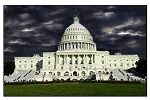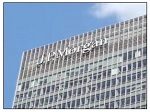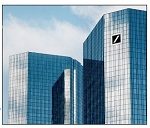-
Recent Posts
- Trump’s “Big Beautiful Bill” Is a Grotesque Giveaway to Fossil Fuel Billionaires While Adding $3.3 Trillion to Nation’s Debt
- Senator Chris Murphy Charges that Trump “Has Opened a Channel for Bribery”
- Congressman Casten: Trump’s Assault on the Rule of Law Is Causing Capital Flight Out of U.S. by Foreign Investors
- Trump’s Approval Rating Drops to 80-Year Low; IMF Says U.S. Tariffs Now Exceed the Highs During the Great Depression
- Nasdaq Has Lost More than 3,000 Points Since Trump’s First Full Day in Office in 2025; the Pain Has Barely Begun
- The Bond Crisis Last Week Was a Global No-Confidence Vote in U. S. President Donald Trump
- Trump’s Tariff Plan Guts $5 Trillion in Stock Value in Two Days; Senator Warren Calls for Emergency Action Before Markets Open on Monday
- Trump’s Attacks on Big Law, Universities, and the Media Have a Common Goal: Silence Dissent Against Authoritarian Rule
- Trump Administration Gives All Clear to Laundering Money through Shell Companies and Bribing Foreign Officials
- Four Megabanks on Wall Street Hold $3.2 Trillion in Uninsured Deposits – Which May Explain Senator Schumer’s Pivot to the GOP to Stop a Government Shutdown
- Here’s What Came Crashing Down Yesterday for Trump’s “Genius” Guy, Elon Musk: Tesla Stock, Access to Twitter (X), His Years of Secret Calls with Putin
- After Banning the Associated Press, Trump Is Now Targeting Specific Journalists That He Wants to See Fired
- Closely Watched Atlanta Fed Model Predicts Negative U.S. Growth in First Quarter
- Trump’s Gangster Diplomacy Makes Front Page Headlines Around the Globe
- Who Benefits Alongside Elon Musk If He Succeeds in Killing the CFPB: the Megabanks on Wall Street that Underwrite His Tesla Stock Offerings
- In Trump 1.0, the State Department Used Taxpayer Money to Publish a Book Elevating Elon Musk to a Superhero; It Was Funded by USAID, the Agency Musk Wants to Quickly Shut Down
- News Host Joy Reid Raises Threat of Trump Selling U.S. to Putin; Ten Days Later Her Show Is Cancelled
- Elon Musk’s DOGE Appears to Be Violating a Court Order; It Has Taken Down Hundreds of YouTube Videos that Educate Americans on How to Avoid Being Swindled
- Barron’s Releases Audio of Jamie Dimon Cursing Out His Workers at a Town Hall, as Dimon Plans to Dump Another One Million JPM Shares
- There’s One Federal Investigative Agency that Neither Trump nor Elon Musk Can Touch: It Just Opened an Investigation into DOGE
- Elon Musk’s Companies Were Under Investigation by Five Inspectors General When the Trump Administration Fired Them and Made Musk the Investigator
- Donald Trump Gives the Greenlight to Goldman Sachs and JPMorgan Chase to Return to Bribing Foreign Officials
- After Tech Geeks Built a Back Door to Loot Billions from FTX, Republicans Refuse to Investigate What Elon Musk’s Tech-Squad Did Inside the U.S. Treasury’s Payment System
- Former Prosecutor, Now U.S. Senator, Informs Tesla That CEO Musk May Be Violating Federal Law and to “Preserve All Records”
- Trump’s Hedge Fund Guy Is Now Overseeing the U.S. Treasury, IRS, OCC, U.S. Mint, FinCEN, F-SOC, and the Consumer Financial Protection Bureau
- As Elon Musk Begins Shutting Down Payments to Federal Contractors, a Strange Money Trail Emerges to His Operatives Inside the U.S. Treasury’s Payment System
- JPMorgan Chase Charged by Yet Another Internal Whistleblower with Cooking the Books
- We Asked Google’s AI Search Model, Gemini, Questions About the Fed and Wall Street Megabanks: It Got the Answers Dead Wrong
- With Trump and Melania’s Crypto Coins Likely to Raise Legal Challenges, Why Didn’t Trump Fire the SEC’s Inspector General in His Purge of IGs?
- Fossil Fuel Industry Could End Up Paying Tens of Billions for LA Wildfires and Deceiving the Public on Climate Change for Decades
- It’s Being Called the Biggest Grift by a President in U.S. History: Trump and First Lady Launch their Own Crypto Coins
- Trump Plans to Install a Fracking CEO to Head the Energy Department and Declare a National Emergency on Energy to Gain Vast Powers
- Fossil Fuel Money Played a Role in the Los Angeles Fires and the Push to Install Pete Hegseth as Secretary of Defense
- When It Comes to Wealth Retention in Retirement, Concrete May Be the New Gold
- Wall Street Watchdog Warns “Clock Is Ticking on a Coming Catastrophic Financial Crash”
- Wall Street Is Sending the Same Message to Americans on Fossil Fuel Financing that It Sent on Cigarettes: Drop Dead
- In a Six-Week Span, this Dark Pool with a Curious Past Traded 3.7 Billion Shares
- Wall Street’s Lobby Firm Hired Eugene Scalia of Gibson Dunn to Sue the Fed for Jamie Dimon
- Postmaster General Louis DeJoy Made $561,051 in Compensation in 2024, as Mail Costs Spiked and Delivery Deteriorated
- Fed Chair Jay Powell Sends a Bold Message to Trump and Tanks the Dow by 1123 Points
- The Head of Fixed Income at T. Rowe Price Makes the Scary Case for the 10-Year Treasury to Spike to 6 Percent
- $663 Billion in Cash Assets Have Gone Poof at the Largest U.S. Banks
- Donald Trump to Ring Bell at New York Stock Exchange Today as Hit List Posters Appear in Manhattan Targeting Wall Street CEOs
- Trump Has a Slush Fund to Prop Up the Dollar – Will He Use It to Prop Up Bitcoin Instead?
- A CEO Assassination; a Billionaire Heiress/NYPD Commissioner; a Secret Wall Street Spy Center – Here’s How They’re Connected
- Despite More than 1600 Tech Scientists Signing a Letter Calling Crypto a Sham, Trump Names a Crypto Cheerleader for SEC Chair
- The Fed Rings a Warning Bell: Hedge Funds and Life Insurers Are Reporting Historic Leverage
- Trump’s Nominee for FBI Director, Kash Patel, Has Businesses Financially Intertwined with Trump
- Donald Trump Is at Risk of Getting Named in a Fossil Fuels Conspiracy Lawsuit
- Trump Is Having Difficulty Getting a Lawyer to Accept the Nomination for SEC Chair: Here’s Why
Search Results for: JPMorgan
JPMorgan Chase Quietly Settles Whistleblower Case Involving Charges of Keeping Two Sets of Books and Improper Payments to Tony Blair

By Pam Martens and Russ Martens: October 26, 2022 ~ It was a lawsuit that should have made front page headlines in every major newspaper in America and on the evening television news. Instead, as we predicted, it was quietly settled on Monday, just 10 business days before a trial was scheduled to begin. The dollar amount of the settlement was not disclosed. Yesterday, Wall Street’s paper of record, the Wall Street Journal, devoted a mere 299 words to the settlement and the details of the case. The lawsuit was filed in the federal district court for the Southern District of New York – a court system where mega Wall Street banks have a long history of evading justice. The plaintiff in the case is Shaquala Williams, an attorney and financial crimes compliance professional with more than a decade of experience at multiple global banks. The defendant is JPMorgan Chase – … Continue reading
JPMorgan Chase, Morgan Stanley and Wells Fargo Flunk a Test Measuring their Support for American Democracy

By Pam Martens and Russ Martens: September 15, 2022 ~ The nonpartisan watchdog group, Accountable.US, has released the results of an investigation into how committed to democracy the 100 largest corporations in America are. The corporations were graded on support for voting rights, the electoral process, and American democracy. The results were provided in an interactive resource called the American Democracy Scorecard. Researchers looked at 14 key criteria. Seven elements of the criteria involved making pro-democracy statements, being affiliated with pro-democracy organizations, and taking other pro-democracy actions. Seven other criteria involved corporate contributions to elected officials who are undermining democracy and voting rights. Three of the largest mega banks on Wall Street, JPMorgan Chase, Morgan Stanley, and Wells Fargo, flunked the democracy test, each receiving a score of “F.” Goldman Sachs received a “D.” Bank of America and Citigroup received a “B” grade, but, clearly, that was based on very recent … Continue reading
JPMorgan Chase’s Stock Is a Dog – Put on a Leash by the Fed and Down 28 Percent Year-to-Date

By Pam Martens and Russ Martens: August 30, 2022 ~ According to YCharts (give the chart time to load) since January 1, 2017 through December 31, 2021 – a span of five years – JPMorgan Chase has spent a total of $84.312 billion buying back its own stock. In eight of those quarters, it spent more than $5 billion buying back its own shares. In the three quarters when JPMorgan Chase was on a secret feeding tube from the Fed via the Fed’s emergency repo loans and other emergency programs, the bank bought back the most stock in its history according to YCharts: $6.949 billion for the quarter ending September 30, 2019; $6.751 billion for the quarter ending December 31, 2019; and $6.517 billion for the quarter ending March 31, 2020. Now, the unthinkable has happened. The Fed has actually put JPMorgan Chase on a leash. As a result, the bank … Continue reading
JPMorgan Chase Failed to Disclose Its Role in Financing a $1.8 Billion Loan to a Ski Resort Deal Tied to an “Independent” Board Member

By Pam Martens and Russ Martens: August 22, 2022 ~ Last week the Federal Reserve announced that it was banning Ronald D. Paul for life from the banking industry. Paul is the former Chairman and CEO of EagleBank, a small bank operating 20 offices in Maryland, Washington, D.C. and Virginia. The Fed also announced it was fining EagleBank $9.5 million for violating the Board’s “insider lending regulation,” over EagleBank extending “credit totaling nearly $100 million to entities that Paul owned or controlled, including certain family trusts, without making appropriate disclosures….” This is just one more case of the Federal Reserve going after the little fish while taking a hands-off approach to the killer whales – the megabanks on Wall Street. For more than a decade, JPMorgan Chase has been asserting in its proxy statement that its entire Board of Directors, other than Jamie Dimon, consists of independent directors. In its most … Continue reading
Judge Orders Jury Trial for JPMorgan Whistleblower Who Claims Bank Fired Her for Reporting Suspicious Payments to Former U.K. Prime Minister Tony Blair

By Pam Martens and Russ Martens: August 3, 2022 ~ Playing out in a federal courtroom in Chicago have been JPMorgan traders telling a jury that it was standard operating procedure at the bank to rig precious metals markets in order to make huge profits for their trading desk. That case is U.S. v. Smith in the Northern District Court in Chicago. (Case number 1:19-cr-00669.) Now there may be more explosive revelations spilling out against JPMorgan Chase in the Southern District Court in Manhattan beginning this fall. That case is Shaquala Williams v JPMorgan Chase. (Case number 1:21-cv-0932.) Last week, Judge Jed Rakoff, who is overseeing the Williams case, ruled that JPMorgan’s motion for dismissal would not prevail on Williams’ claim for retaliatory dismissal and ruled that a jury trial would begin on November 7. (Judge Rakoff did dismiss the Williams’ claim that the bank’s actions had adversely affected a job offer.) … Continue reading
Federal Data Show JPMorgan Chase Is, By Far, the Riskiest Bank in the U.S.

By Pam Martens and Russ Martens: July 26, 2022 ~ The long-tenured Chairman and CEO of JPMorgan Chase, Jamie Dimon, likes to use the phrase “fortress balance sheet,” when talking about his bank to Congress or shareholders. But the data stored at its federal regulators show that the bank is, by far, the most systemically dangerous bank in the United States. And, despite its high risk profile, neither Congress nor federal regulators have restricted its growth. Its assets have soared by 65 percent since the end of 2016 and stood at $3.95 trillion as of March 31, making it the largest bank in the United States. Making this situation even more dangerous, the bank has admitted to five criminal felony counts over the past eight years and a multitude of civil crimes and multi-billion dollar fines — all during the tenure of Dimon. Neither Congress nor federal regulators nor the Justice Department … Continue reading
There Are Three Separate Cases in Federal Court Accusing JPMorgan Chase of a Culture of Fraud

By Pam Martens and Russ Martens: July 19, 2022 ~ JPMorgan Chase is the largest federally-insured bank in the United States. It is also one of the largest trading houses on Wall Street. That’s the Faustian bargain the Clinton administration entered into with Wall Street when it repealed the Glass-Steagall Act in 1999. According to data from the FDIC, as of June 30 of last year, JPMorgan Chase Bank N.A. had 4,925 branches in 44 U.S. states holding $2.01 trillion in deposits. Many of those deposits belong to mom and pop savers who have no idea that the bank has admitted to five criminal felony counts since 2014 and has a rap sheet that is the envy of the Gambino crime family. (Apparently, a federal judge in New York overseeing a current JPMorgan case is just as naïve about the bank’s criminal history. More on that shortly.) The bulk of Americans … Continue reading
Here Are the Orwellian Details of the U.S. Patent JPMorgan Got Approved for Its Sprawling System of Spying on Employees

By Pam Martens and Russ Martens: July 8, 2022 ~ In 2018, Bloomberg reporters Peter Waldman, Lizette Chapman, and Jordan Robertson published a stunning expose on how JPMorgan Chase was spying on its employees, including after hours, using as many as 120 engineers from the data mining company Palantir Technologies Inc. According to the Bloomberg report, “It all ended when the bank’s senior executives learned that they, too, were being watched, and what began as a promising marriage of masters of big data and global finance descended into a spying scandal.” But the surveillance program did not end. The bank simply developed its own proprietary spying system instead. Business Insider reporter, Reed Alexander, has reignited the scandal with the news that the internal surveillance program at JPMorgan Chase is now called “Workforce Activity Data Utility” or WADU. According to Business Insider, the surveillance is fostering paranoia inside the bank with … Continue reading
Deutsche Bank and JPMorgan Chase Have Been Trading Like Clones for Two Months; Both Are Down Almost 30 Percent Year-to-Date

By Pam Martens and Russ Martens: June 30, 2022 ~ JPMorgan Chase’s stock has lost 27 percent of its market value year-to-date through its June 29 closing price. But more disturbing than that is the above chart showing that the behemoth German lender, Deutsche Bank, has been trading like a clone of JPMorgan Chase for the past two months. Deutsche Bank’s stock price is down just one percentage point more than JPMorgan Chase year-to-date. JPMorgan Chase is the largest federally-insured bank in the United States. Looking like one is tied with an umbilical cord to Deutsche Bank has its perils on Wall Street. Let’s start with the raids on the Deutsche Bank’s headquarters, two of which coincided with dead bodies turning up. On November 29, 2018, Deutsche Bank’s headquarters in Germany were raided by 170 members of law enforcement. Prosecutors explained the action by stating that “Deutsche Bank helped customers found … Continue reading
Report: JPMorgan Chase and Citibank Hold 90 Percent of All Gold and Other Precious Metals Derivatives Held by All U.S. Banks

By Pam Martens and Russ Martens: June 29, 2022 ~ Last Tuesday, the Office of the Comptroller of the Currency (OCC) released its quarterly report on derivatives held at the megabanks on Wall Street. As we browsed through the standard graphs that are included in the quarterly report, one graph jumped out at us. It showed a measured growth in precious metals derivatives at insured U.S. commercial banks and savings associations over the past two decades and then an explosion in growth between the last quarter of 2021 and the end of the first quarter of this year. In just one quarter, precious metals derivatives had soared from $79.28 billion to $491.87 billion. That’s a 520 percent increase in a span of three months. (See Figure 18 at this link. The last ten years of the graph is shown above.) Having studied these quarterly reports since the 2008 financial crash, we … Continue reading

